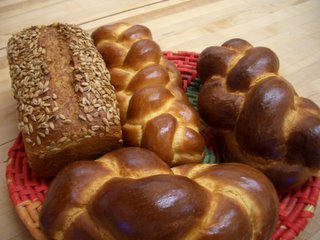Week 1 Wrap Up Over Bread
 These are samples of the lovely challahs and sunflower pullmans we made on Friday. Chad and I took the weekend to finish the two-braided one on the bottom.
These are samples of the lovely challahs and sunflower pullmans we made on Friday. Chad and I took the weekend to finish the two-braided one on the bottom.I've been debating with myself how to talk about culinary school on the blog. On the one hand, I want to share the detailed knowledge that I am gaining in technique and science, but on the other hand, there are already so many books that already say the same things about baking--and many people, esp people who read food blogs, probably already know a good bit of that already. And if I write entire recipes -- even recipes scaled down from, say, 6 pies to 1 pie -- it also kind of misses the point, esp since the facilities at the school are different from the average kitchen. We're not really learning recipes--the closest thing may be ratios--but we are learning technique. And that's really best learned by doing, or gathering as much info as possible and then doing it on your own.
So, the best I could come up with for now is to share the bits that I didn't know -- and probably the occasional fantastic recipe.
So, here are some things that came up on breads and cookies this past week:
- If you have begun mixing bread dough and discover that you have mistakenly used only half the water necessary, you must throw it out and start again. Otherwise, since gluten has already formed, the additional water will not distribute evenly, and you'll be left with a wet paste laden with chunks of protein. You can add a little bit of water if the dough is too dry, though, and you have already measured correctly.
- If you make tart dough a day ahead and mistakenly put it in the freezer instead of the refrigerator overnight, then mixing it for a little while in a mixer with a bread hook will soften it up without making the butter melt. You could also put it in the fridge, but it'll take a long time to thaw.
- Although one of our books has pretty much all the recipes we make, we have to write them out by hand onto index cards to use in class; they are best kept in a small flip photo album. This is one of the more tedious things to do, since you have to copy the recipe, make sure it fits onto the card, incorporate add'l notes from the chef when he went over the recipe, and the legibility of my handwriting only barely rivals that of a 2nd grader with a sprained wrist. I think of it as the culinary equivalent of writing briefs of cases for law school.
- Pullman pans for bread (our common sandwich loaf) were created by one of the railroad Pullman's. It's rectangular shape made them store more efficiently.
- It's especially easy to burn bread that's in the oven during lunch on Friday, because people are just feeling too good to rest and look forward to the weekend to get up and check it.
- Challah should have the flaky internal consistency of a croissants, but bread-like. The strands are braided together, so that when cut, each slice has a cross section of a strand that oriented slightly differently, so that the crumb can be arc-like. Striations on the outside of the bread, though, are a sign of it being overworked or dried out when it was dough.
- Slashing bread not only looks nice, but lets the bread expand evenly from its gases inside. Otherwise, bread will puff irregularly. Also, slashes alone can force the bread into an oval or square shape, among others.
- Empty "tunnels" in brownies, and other such baked goods, are a sign of over-mixing the flour into the batter. The flour built structures within the bread that stayed during baking.
- The deck oven used by the school has 4 levels and is at least 6 ft deep. It has buttons to release steam, usually both before and after loading it (but egg-washed breads are not steamed). And it's temperature is set according to the % to the top and the bottom; it was usually 40% top heat, 60% bottom. It makes amazing bread.
- Bread is usually done when it has an internal temp of 195 degrees F.
- If batards aren't rolled tight enough, they will flatten.
- Shaping dough is key, and although some moves are the same, it varies widely between each bread.
- Fougasse, the leaf shaped loaf with holes, is fun to make. But if you are putting olive oil and sea salt on top for flavoring, apply before the final proof, or else it will have to proof longer if added partway into it.
- Bread has been properly proofed and ready to bake when it no longer springs back after being poked.
- When fermenting and baking, it's important to know if the seam side of dough should be up or down.
0 Comments:
Post a Comment
<< Home